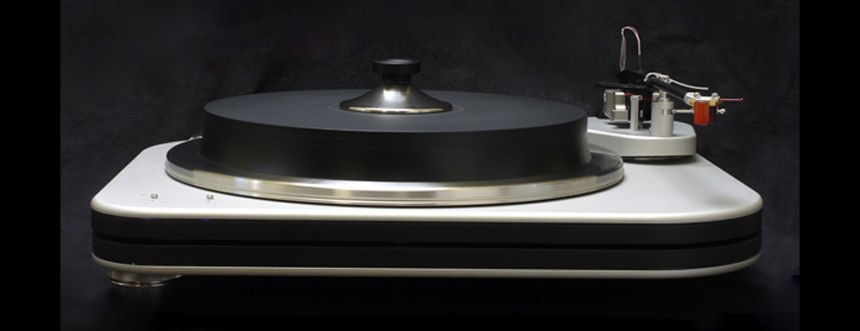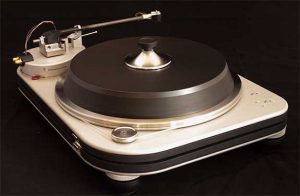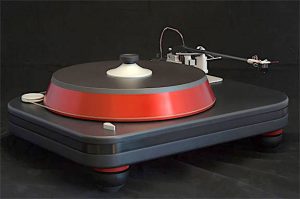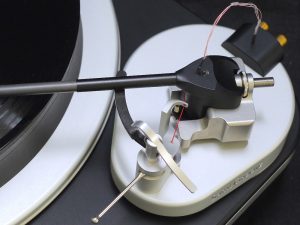
Spiral Groove SG1.2, Revolution turntables and the Centroid arm
The design of these two turntables fits perfectly with our growing understanding of the paramount need to control vibration in music systems. The pernicious effects of vibration are nearly always badly understood, unrecognised or even ignored, not just by listeners but, sadly, also by many manufacturers.

SG 1.2 with the Centroid arm on its bayonet mount
Its effects are to create out-of-phase spurious signals in microphonic components (most circuit board items!) which then intermodulate, or react, with the music signal to create a hard edge, loss of detail and soundstage and loose, ill-timed bass. Realism and presence suffer to the point where the music loses its drama and interest.
If you accept the concept of vibration damage you’ll realise that designing to control unwanted energy in a turntable, handling the most minute signals, is exceptionally difficult. SpiralGroove use sophisticated computer analysis to model the flow of energy throughout the structures, allowing them to direct and absorb it.
Do these turntables have a fault? Yes – for some audiophile they don’t look “techy” enough! Some other turntables can look like oil rigs, but don’t let the simple, uncluttered appearance of the Spiral Grooves fool you – there is a world of original thought and superb engineering under the surface.
Spiral Groove design features
The SG1.2 and SG2 use multi-layer damping in the plinth and the platter – with the motor, the arm and the bearing all mounted on different layers.
Solid construction ensures that stylus, arm pivot, platter bearing and motor remain in an absolutely fixed relationship, unlike suspended turntables that are perpetually in motion as they try to correct, after the event, for the dynamic forces from airborne energy, the pull of the motor and the changing drag of the stylus as it tracks music.
Spiral Groove have won several ‘Product of the Year’ awards and comments such as “…this may be the best tonearm I’ve heard” and of the SG2 “…it transcends expectations – it’s something special” both from the US magazine Stereophile. And another comprehensive piece by the experienced reviewer Martin Colloms in HIFI CRITIC

Spiral Groove SG2 Revolution and Centroid arm
The huge benefits that stem from controlling the energy include incredibly quiet backgrounds, retrieving fine detail that reveals a wide and deep soundstage populated with accurately-placed performers and precise rhythm and timing. Spiral Groove achieve these musically-essential standards with:
• multiple damped layers in the plinths, seven in the SG1.2 and five in the SG2
• multi-layer platter with a graphite record surface
• oversize platter drive ring for excellent speed stability
, giving vanishingly low wow
• centre spindle decoupled from the bearing
• magnetic support bearing
• external voltage generating power supply, with fine 33 and 45rpm speed adjustment
As well as its superior energy damping the SG1.2 also offers a bayonet mount for the arm. This invaluable facility allows for near-instantaneous exchange of arms as a complete assembly, without any need for set-up adjustments, if the user needs alternative cartridges, eg for 78 records. It also makes for very convenient and accurate cartridge mounting. Mounts are available for a number of popular arms, such as the Graham.
Prices: SG1.2 £27,500 and SG2 £15,000
Spiral Groove Centroid Tonearm
Best performance from a cartridge is possible only if the arm is easy to set up and offers precise adjustment of all the parameters. This one does. It is a delight compared with the difficulties you encounter with so many otherwise good performers.

Centroid arm on a fixed SG2 mount
Moreover, with its rigid Balanced Force Design it dumps unwanted energy fast. A version of the arm can use the quick-change bayonet mount feature on the SG1.2 turntable. Allen Perkins’s Balanced Force Design is fundamentally simple yet highly innovative in implementation. It underpins all aspects of the turntables and arm and you will find this explanation helpful: Balanced Force Design
“…this may be the best tonearm I’ve heard. Its sound is different in ways that will open people’s ears, and I predict that it will affect the design of every tonearm from now on.” – Brian Damkroger, Stereophile.
There are versions of the arm for SG turntables and a Universal one, all £5,900.
Here is a link to the Spiral Groove site: Spiral Groove home
Reviews: Stereophile S’phile SG2 and S’phile Centroid arm


